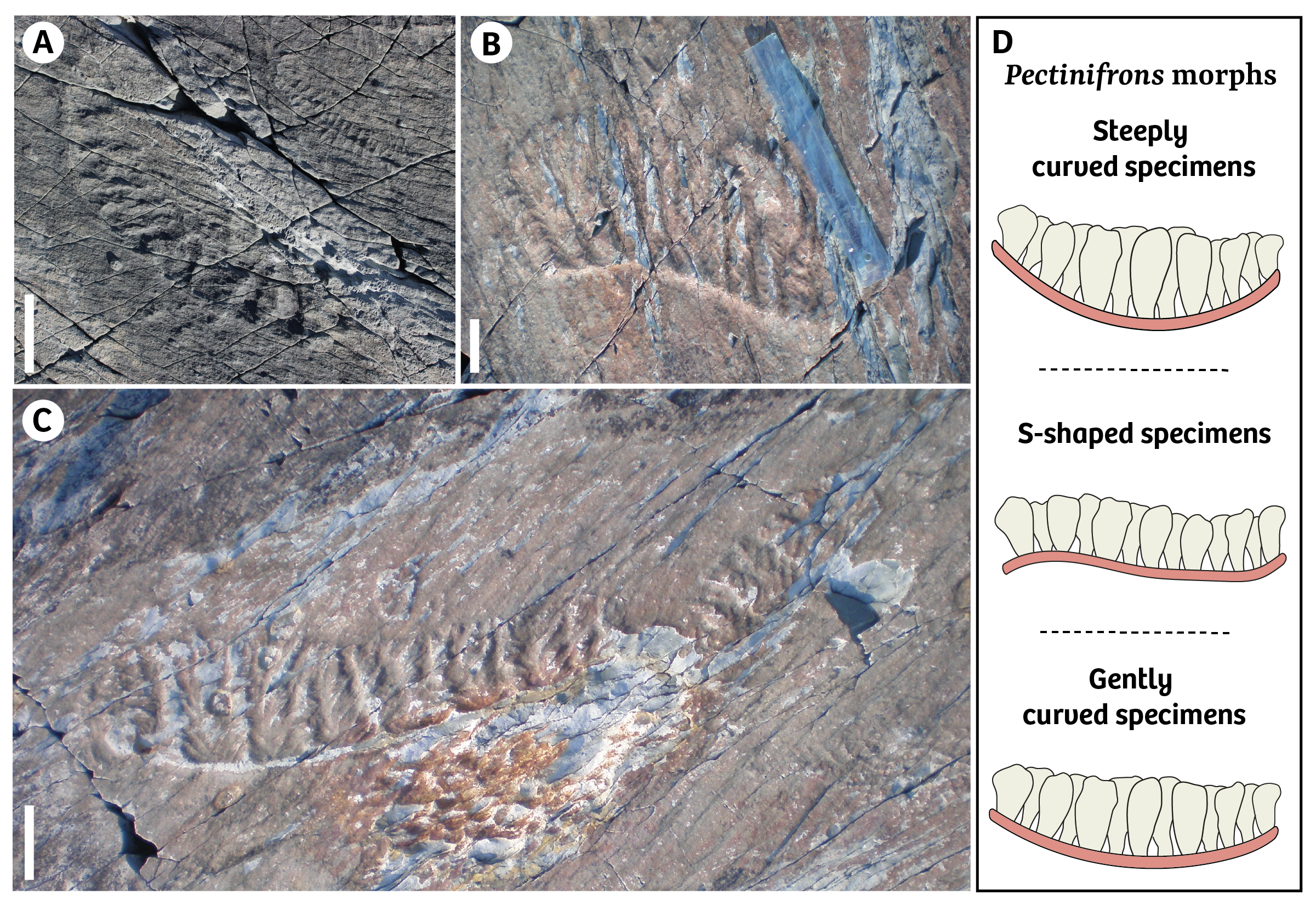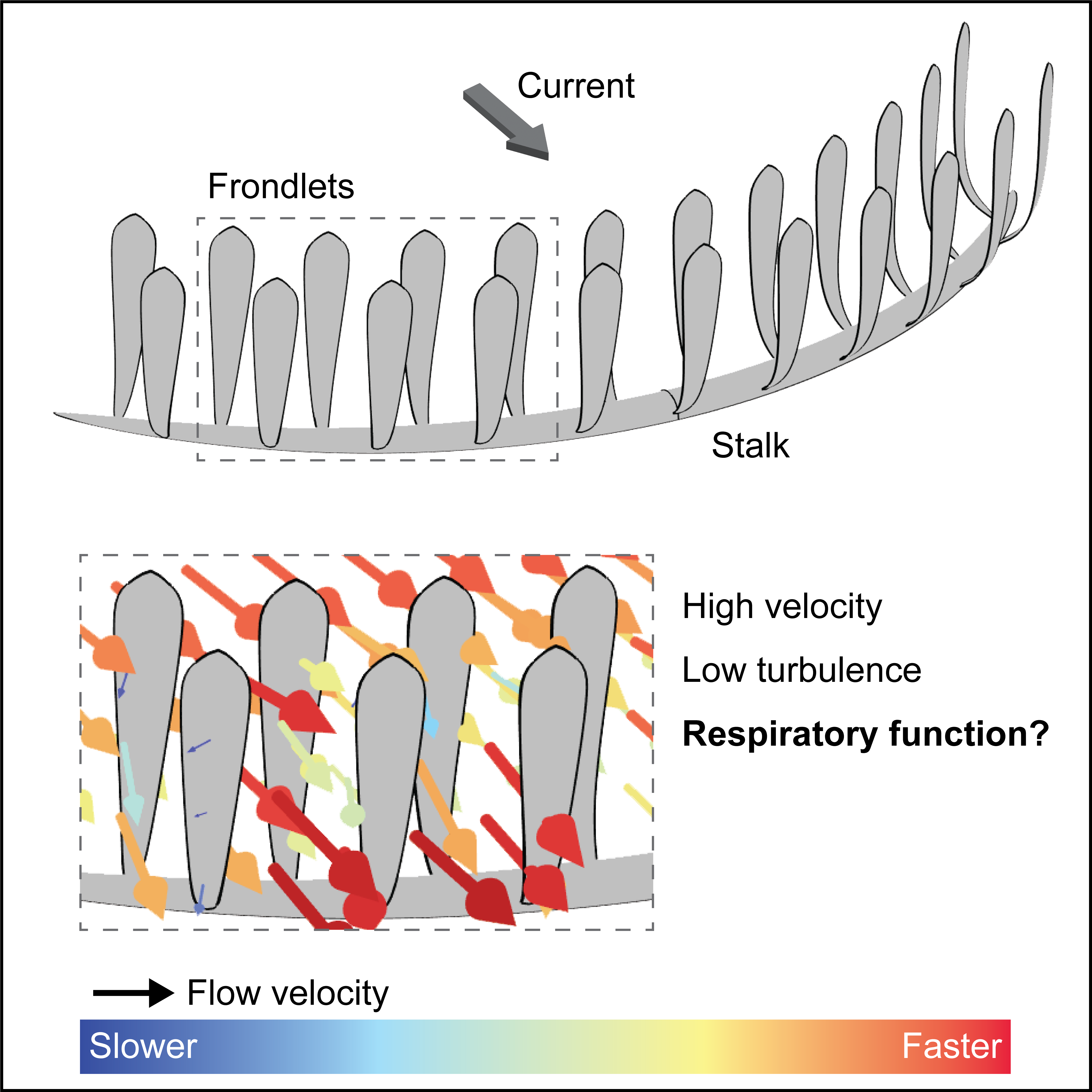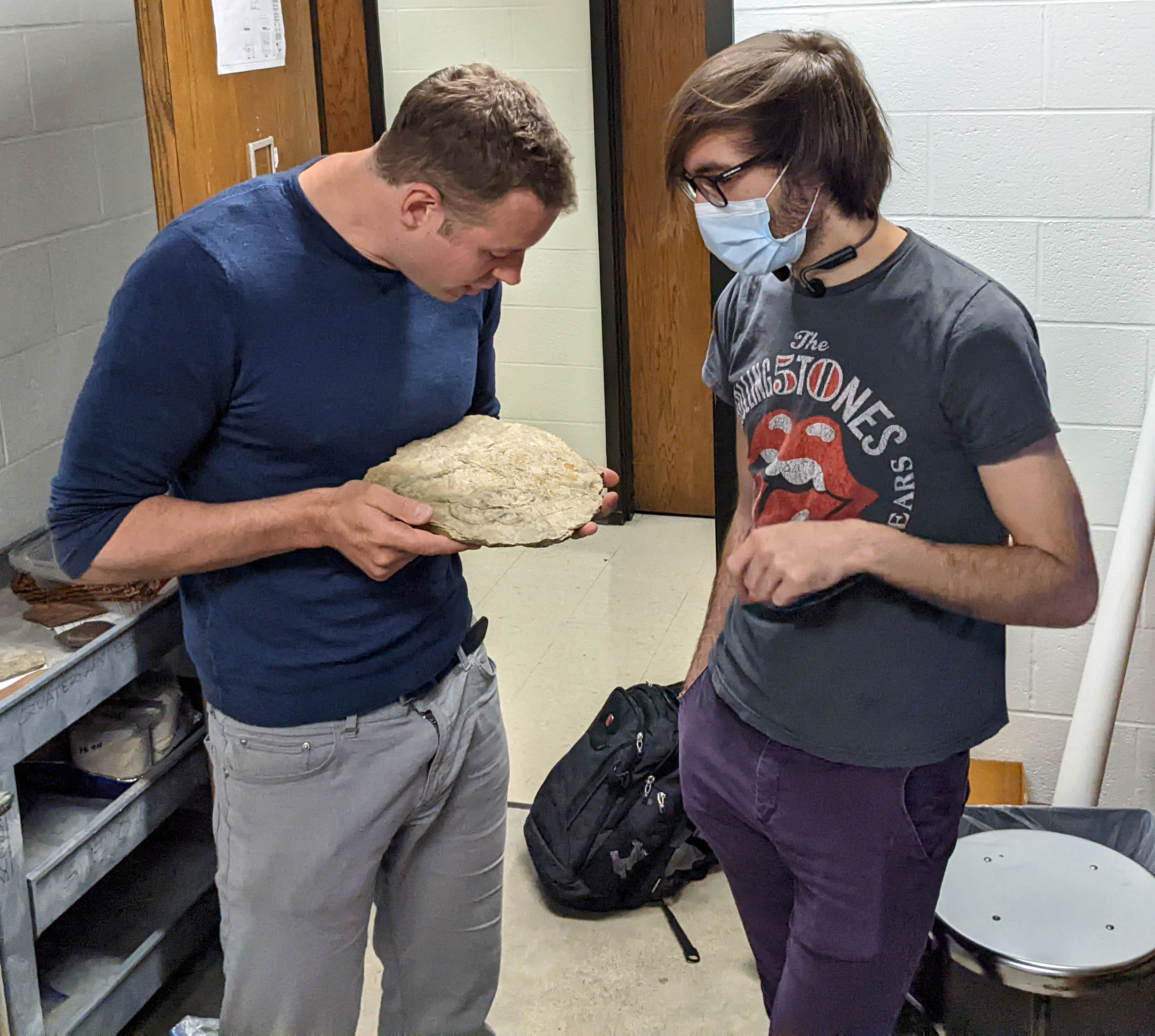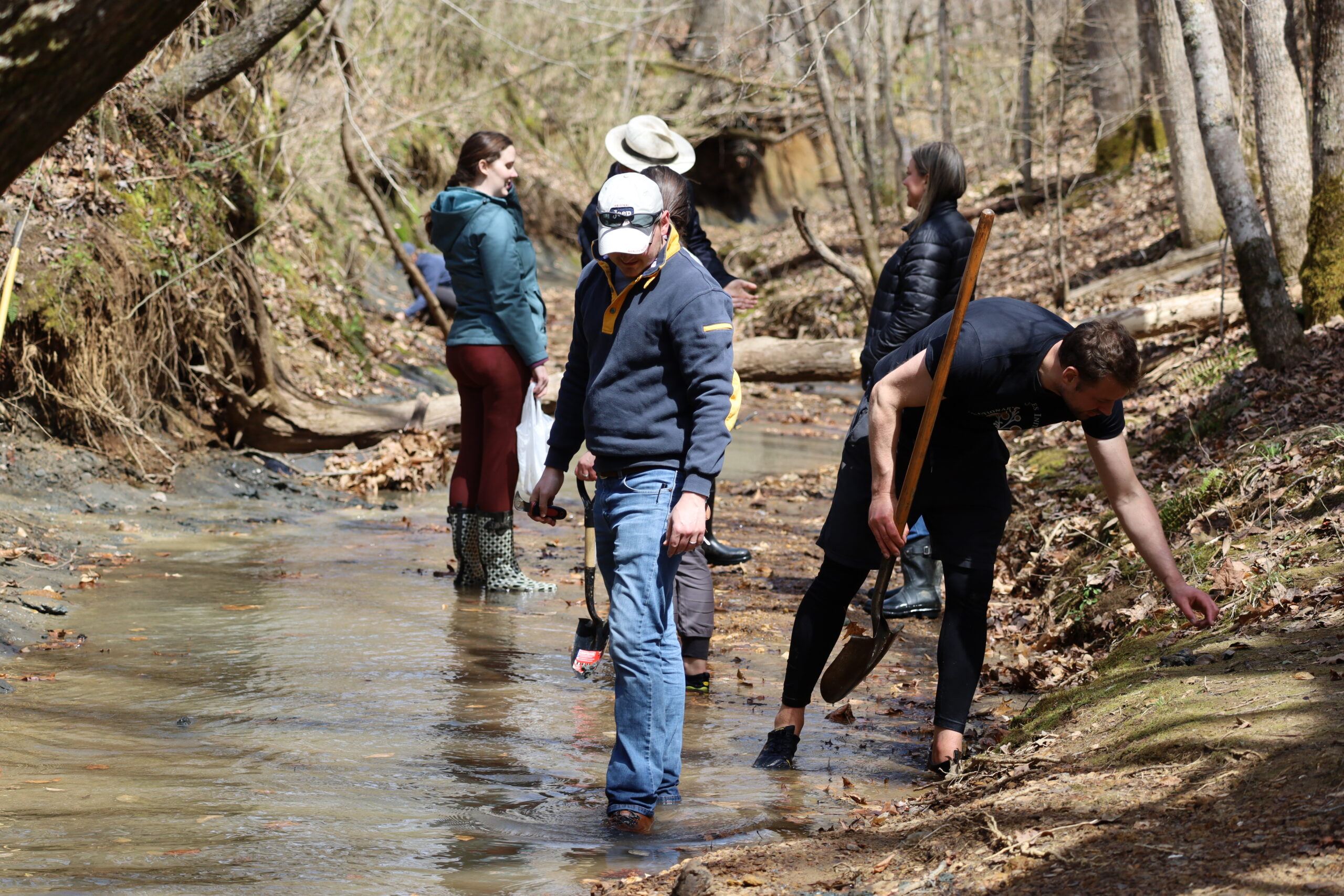Vanderbilt-led Group Discovers Divergent Function in Convergent Evolution of Form
By: Andy Flick, Evolutionary Studies scientific coordinator

(A–C) Photographs of steep ‘U’-shaped (A), ‘S’-shaped (B), and gentle ‘U’-shaped (C) morphotypes of Pectinifrons. Scale bars: 5 cm.
(D) Schematic diagrams of Pectinifrons morphotypes.
The classic idiom form fits function does not always mean that everything of the same form has the same function. That’s what a group of paleontologists have discovered with the help of fluid physics and preserved fossils. Simon Darroch, assistant professor of Earth and Environmental Sciences, led a team that studied the function of the comb-shaped ancient rangeomorph organism, Pectinifrons abyssalis.
Pectinifrons abyssalis lived deep below the sea roughly 570 million years ago. The bottom of the organism laid on the sea floor and was roughly worm-shaped with frondlets (imagine comb teeth) extending upward. The currently living harp sponges have a similar shape with the upward extending ‘vanes’ used for feeding. Using computational fluid dynamics (CFD), the team deduced that the ancient rangeomorph likely used its frondlets for gas exchange, rather than feeding.

According to Darroch, “we think the upright frondlets were organs for breathing rather than feeding. If we’re right, this requires us to re-imagine the oldest macroscopic animals as highly adapted to scavenging oxygen in an ocean that was only periodically oxygenated, rather than adapted for feeding. Not only does this bring us closer to understanding what these critters were, but also helps us understand the environment in which they evolved and the constraints on early animal evolution.”
Digital models of Pectinifrons were created by postdoctoral researcher at the Natural History Museum in London, Susana Gutarra, and undergraduate researcher in the Darroch lab, Hale Masaki. CFD simulations were run by Imran Rahman, a principal researcher at the Natural History Museum. Rahman also visualized the results.
Current postdoctoral researcher and former Ph.D. student in the Darroch lab, Brandt Gibson, is keenly interested in uncovering the biology and ecology of these ancient rangeomorphs. He is excited to be studying the oldest macroscopic communities ever found and documenting the rapid evolution of organisms on ancient Earth. He noted that life changed very quickly in the Ediacaran Period, the period when rangeomorphs lived.
Focusing in on rangeomorph anatomy was Frances Dunn, a research fellow at the Oxford Museum of Natural History. While others on the team (like Darroch and Gibson) were interested in the paleoecology, Dunn provided insight into the best way to actually form the model of P. abyssalis for computational fluid dynamics. Understanding the anatomy is the first step to building a functional model.
Working at the community level, Emily Mitchell, an assistant professor at the University of Cambridge, provided insight from Pectinifrons specimens collected in various fossil surfaces and the communities they may have lived in. She also works in current ecosystems and was able to provide an appropriate modern sponge for computational fluid dynamics comparisons.
On working together:
Darroch expressed his overwhelming joy from working with this group as well. He commented that the group is able to get so much accomplished because they work well as a team. He is especially proud of the undergraduates on this project – Hale Masaki and Andrei Olaru – noting that they brought incredible enthusiasm to the project.
Gibson took on a more advisory role than he had in the past and enjoyed challenging ideas and helping interpret some of the results the team got. He noted several members of the group had wanted to work on the dichotomy of feeding vs gas exchange, and this project provided a way to get to it.

Olaru said the admiration was mutual. He noted that the lab environment of the Darroch lab was nurturing, and he felt respected as a young scientist. He also commented on his enthusiasm for the types of research the lab investigates.
He even commented, “who doesn’t want to work on the deepest mysteries of the biosphere?”
Darroch continued by talking about the nature of collaborating with folks from Europe. The group they have put together are wonderful for Ediacaran systematics and computational fluid dynamics. While the group regularly meets via Zoom, they’ve managed to get together in person three times over the years for valuable meetings.
Dunn agreed about the effectiveness of the group. Dunn appreciates the supportive environment cultivated by Darroch and the others and loves being able to connect so easily with experts in her field. Mitchell echoed these sentiments with special excitement about the complimentary skillsets of the team.
Several of the group, including Rahman talked about the open nature of the collaboration. Often times in academia, people can be secretive and worried about being scooped by potential collaborators turned adversaries. Rahman noted that the collaborative and open nature of the group makes working together a pleasure.
On connections to Evolution at Vanderbilt:

Darroch, the lead investigator in this group, is on the seminar series committee for the Evolutionary Studies Initiative at Vanderbilt University. He is interested in evolution of early life on Earth and has even written a grant to study geologic evidence for life that may be useful for searching for signs of ancient life on other planets. On this project, rangeomorphs provide a sort of proof of concept for studying evolutionary radiations.
Darroch said, “because rangeomorphs appear before just about everything else in the Ediacaran, and are thus perhaps the key to understanding the first major evolutionary radiation of complex eukaryotes, it was important that we took our methods for a test drive trying to pick it apart. It is also key to understand the environment in which rangeomorphs lived and the general constraints on early animal evolution.”
Gibson, having been trained in the Darroch lab, echoed that understanding these rangeomorphs will shed light on life in these early ecosystems. He also mentioned that Vanderbilt, in particular the Biology and Earth and Environmental Sciences departments, was a great place to study the evolution of life on early Earth.
Gibson noted, “as it’s often easier to learn by doing, students should reach out to faculty conducting cool research. There are so many unknowns that are currently being investigated at VU, and there’s only so much time to work on a given question. Most faculty love collaborating with junior scientists, and it’s a great way to gain firsthand experience on studying evolution and paleontology beyond Vanderbilt.”
Funding Statement: This research was supported by joint funding from the US National Science Foundation (NSF-NERC EAR-2007928) and the UK Natural Environment Research Council (NE/V010859/2). E.G.M. also acknowledges funding from the Natural Environment Research Council (NE/S014756/1). S.A.F.D. and R.A.R. acknowledge generous support from the Alexander von Humboldt Foundation. A.O. and H.M. were funded by the Searle Undergraduate Research Program (‘SYBBURE’) and a Vanderbilt Vaughan Fellowship, respectively. B.M.G. acknowledges computational support stemming from two Vanderbilt University Alberstadt, Reeseman, and Sterns grants, and a University of Toronto Mississauga Postdoctoral Fellowship. F.S.D acknowledges additional support from the Royal Commission for the Exhibition of 1851 and Merton College, Oxford. For the purpose of open access, the authors have applied a Creative Commons Attribution (CC BY) license to any Author Accepted Manuscript version arising.
Citation: Darroch, SAF; Gutarra, S; Masaki, H; Olaru, A; Gibson, BM; Dunn, FS; Mitchell, EG; Racicot, RA; Burzynski, G; Rahman, IA. “The rangeomorph Pectinifrons abyssalis: hydrodynamic function at the dawn of animal life.” iScience (2023): 105989. LINK